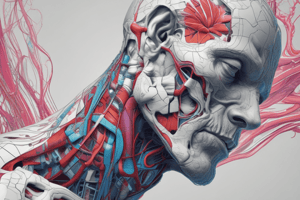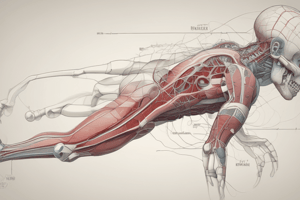Podcast
Questions and Answers
Which body system is responsible for protecting the body from external damage?
Which body system is responsible for protecting the body from external damage?
- Musculoskeletal system
- Circulatory system
- Nervous system
- Integumentary system (correct)
What is the medical term for inflammation of the stomach?
What is the medical term for inflammation of the stomach?
- Gastritis (correct)
- Carditis
- Pulmonitis
- Hepatitis
What type of medication is used to relieve pain?
What type of medication is used to relieve pain?
- Anti-inflammatory
- Analgesics (correct)
- Antibiotics
- Antihistamines
What is the term for maintaining patient privacy?
What is the term for maintaining patient privacy?
What is the device used to measure blood pressure?
What is the device used to measure blood pressure?
What is the term for the prediction of the outcome of a disease or condition?
What is the term for the prediction of the outcome of a disease or condition?
What is the term for the medical records stored digitally?
What is the term for the medical records stored digitally?
What is the term for the unintended effects of a medication?
What is the term for the unintended effects of a medication?
What is the term for the process of teaching patients about their condition and care?
What is the term for the process of teaching patients about their condition and care?
What is the term for the force of blood against artery walls?
What is the term for the force of blood against artery walls?
Flashcards are hidden until you start studying
Study Notes
Anatomy
- Body systems:
- Integumentary system: skin, hair, nails, and associated glands
- Musculoskeletal system: bones, muscles, and tendons
- Nervous system: brain, spinal cord, and nerves
- Circulatory system: heart, blood vessels, and blood
- Respiratory system: lungs, trachea, bronchi, and diaphragm
- Digestive system: mouth, esophagus, stomach, small intestine, and large intestine
- Endocrine system: glands that produce hormones (e.g., thyroid, adrenal, pancreas)
- Urinary system: kidneys, ureters, bladder, and urethra
- Reproductive system: male and female genital organs
- Body cavities:
- Cranial cavity: contains the brain
- Thoracic cavity: contains the heart and lungs
- Abdominal cavity: contains the digestive organs
- Pelvic cavity: contains the reproductive organs
- Directional terms:
- Superior: above
- Inferior: below
- Anterior: front
- Posterior: back
- Medial: towards the midline
- Lateral: away from the midline
- Proximal: near the point of attachment
- Distal: far from the point of attachment
Medical Terminology
- Prefixes:
- Endo-: within
- Exo-: outside
- Hypo-: under
- Hyper-: above
- Anti-: against
- Post-: after
- Pre-: before
- Suffixes:
- -itis: inflammation
- -oma: tumor
- -osis: condition or disease
- -algia: pain
- -ectomy: surgical removal
- Roots:
- Cardi-: heart
- Neuro-: nerve
- Gastr-: stomach
- Pulmon-: lung
- Hepat-: liver
- Common medical terms:
- Diagnosis: identification of a disease or condition
- Prognosis: prediction of the outcome of a disease or condition
- Symptom: subjective experience of a disease or condition
- Sign: objective evidence of a disease or condition
Pharmacology
- Drug categories:
- Analgesics: pain relief
- Antibiotics: bacterial infection treatment
- Antihistamines: allergy treatment
- Antihypertensives: high blood pressure treatment
- Anti-inflammatory: inflammation reduction
- Medication administration:
- Oral: by mouth
- Topical: applied to the skin
- Parenteral: injected or infused
- Inhalation: breathed in
- Medication effects:
- Side effects: unintended effects of a medication
- Adverse effects: harmful effects of a medication
- Contraindications: reasons not to use a medication
- Interactions: effects of combining medications
Administrative Procedures
- Patient communication:
- Confidentiality: maintaining patient privacy
- Informed consent: patient agreement to treatment
- Patient education: teaching patients about their condition and care
- Medical records:
- Electronic health records (EHRs): digital storage of patient information
- Paper records: physical storage of patient information
- HIPAA: Health Insurance Portability and Accountability Act
- Office procedures:
- Scheduling: booking patient appointments
- Billing and coding: assigning codes for insurance reimbursement
- Inventory management: maintaining supplies and equipment
Clinical Procedures
- Vital signs:
- Temperature: body temperature
- Pulse: heart rate
- Blood pressure: force of blood against artery walls
- Respiration: breathing rate
- Oxygen saturation: oxygen levels in the blood
- Diagnostic tests:
- Blood tests: laboratory analysis of blood samples
- Urine tests: laboratory analysis of urine samples
- Imaging studies: X-rays, CT scans, MRI, and ultrasound
- Medical equipment:
- Stethoscope: listening to heart and lung sounds
- Blood pressure cuff: measuring blood pressure
- Thermometer: measuring body temperature
- Pulse oximeter: measuring oxygen saturation
Anatomy
- Human body organized into 11 systems that work together to maintain homeostasis:
- Integumentary system protects the body from external damage and regulates body temperature
- Musculoskeletal system provides support, movement, and protection
- Nervous system controls and coordinates body functions
- Circulatory system transports oxygen and nutrients to cells and removes waste products
- Respiratory system brings oxygen into the body and removes carbon dioxide
- Digestive system breaks down food into nutrients
- Endocrine system produces hormones that regulate various bodily functions
- Urinary system filters waste and excess fluids from the blood
- Reproductive system produces sex cells and supports the development of a fetus
- Body cavities provide space and protection for internal organs:
- Cranial cavity contains the brain
- Thoracic cavity contains the heart and lungs
- Abdominal cavity contains the digestive organs
- Pelvic cavity contains the reproductive organs
- Directional terms used to describe the location of body structures:
- Superior: above
- Inferior: below
- Anterior: front
- Posterior: back
- Medial: towards the midline
- Lateral: away from the midline
- Proximal: near the point of attachment
- Distal: far from the point of attachment
Medical Terminology
- Prefixes modify root words to indicate location, direction, or intensity:
- Endo- means within
- Exo- means outside
- Hypo- means under
- Hyper- means above
- Suffixes indicate the type of condition or procedure:
- -itis means inflammation
- -oma means tumor
- -osis means condition or disease
- -algia means pain
- -ectomy means surgical removal
- Roots provide the core meaning of a medical term:
- Cardi- means heart
- Neuro- means nerve
- Gastr- means stomach
- Pulmon- means lung
- Hepat- means liver
- Common medical terms used in healthcare:
- Diagnosis: identification of a disease or condition
- Prognosis: prediction of the outcome of a disease or condition
- Symptom: subjective experience of a disease or condition
- Sign: objective evidence of a disease or condition
Pharmacology
- Drug categories based on their therapeutic effects:
- Analgesics relieve pain
- Antibiotics treat bacterial infections
- Antihistamines treat allergies
- Antihypertensives lower blood pressure
- Anti-inflammatory reduce inflammation
- Medication administration routes:
- Oral: taken by mouth
- Topical: applied to the skin
- Parenteral: injected or infused
- Inhalation: breathed in
- Medication effects:
- Side effects: unintended effects of a medication
- Adverse effects: harmful effects of a medication
- Contraindications: reasons not to use a medication
- Interactions: effects of combining medications
Administrative Procedures
- Patient communication essential for effective care:
- Confidentiality: maintaining patient privacy
- Informed consent: patient agreement to treatment
- Patient education: teaching patients about their condition and care
- Medical records document patient information:
- Electronic health records (EHRs): digital storage of patient information
- Paper records: physical storage of patient information
- HIPAA: Health Insurance Portability and Accountability Act regulates patient data
- Office procedures ensure efficient operation:
- Scheduling: booking patient appointments
- Billing and coding: assigning codes for insurance reimbursement
- Inventory management: maintaining supplies and equipment
Clinical Procedures
- Vital signs measured to assess patient health:
- Temperature: body temperature
- Pulse: heart rate
- Blood pressure: force of blood against artery walls
- Respiration: breathing rate
- Oxygen saturation: oxygen levels in the blood
- Diagnostic tests help diagnose and monitor conditions:
- Blood tests: laboratory analysis of blood samples
- Urine tests: laboratory analysis of urine samples
- Imaging studies: X-rays, CT scans, MRI, and ultrasound
- Medical equipment used in patient care:
- Stethoscope: listening to heart and lung sounds
- Blood pressure cuff: measuring blood pressure
- Thermometer: measuring body temperature
- Pulse oximeter: measuring oxygen saturation
Studying That Suits You
Use AI to generate personalized quizzes and flashcards to suit your learning preferences.




